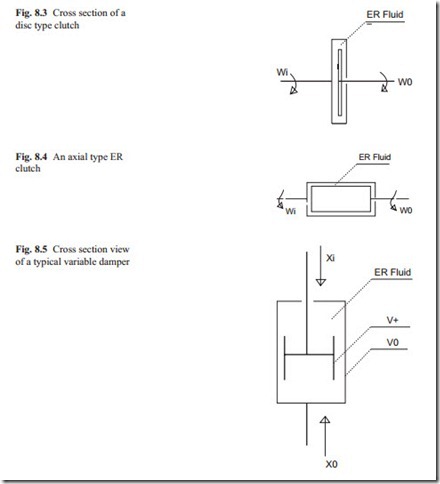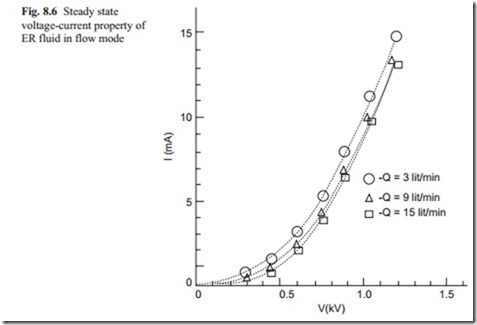Some Possible Applications of ER Fluid
Valves
One interesting application of ER fluids is using them as valves. In this case, the ER fluids may be used as a substitute for hydraulics oil. At present some laboratory ex- periments have been performed to obtain the steady state and dynamic behavior of ER valves. A typical ER valve is shown in Fig. 8.2. It can be made of two concentric cylinders. The high voltage is connected to the inner and outer cylinders.
The length and diameter of the valve depend on the maximum shear stress of the ER fluids. The gap, h, between the inner and outer cylinders depends on several parameters. The ER fluid has zero voltage viscosity which may limit the small range of the gap h. Very high voltage may limit the gap, h, on the larger gap. At present, a gap of fractions of millimeter to one millimeter has been studied and will be pre- sented in the next section.
ER Clutch and Catch Type Actuators
There are two methods of designing ER clutches, one is the disc type and the other one is cylindrical. These are shown in Figs. 8.3 and 8.4.
In both types, the rotating parts (input) are connected to a suitable motor. There- fore, the ER fluid is subjected to a natural cooling system to avoid excessive heat generation. In the disc type, the radial shear is multiplied by radius to give a maxi- mum torque capability. The shear stress multiplied by the radius must be integrated overall contact area. This may have a better torque capability than the axial part.
This exercise is left to the reader to investigate. In the axial type, the shear stress can be assumed to be constant over the gap and the torque capability can be obtained by multiplying the shear stress by the contact area and multiplying the result by the radius.
Variable Dampers Based on ER Fluid
Dampers are usually made of two parts, a moving piston in a cylinder. With ER fluid, a variable damper can be made. This is shown schematically in Fig. 8.5.
The cylinder contains part of a piston or a complete piston. The high voltage is connected to the piston and by varying the voltage a variable damper is obtained. The force generated depends on the damper size and the maximum shear stress of ER fluid.

